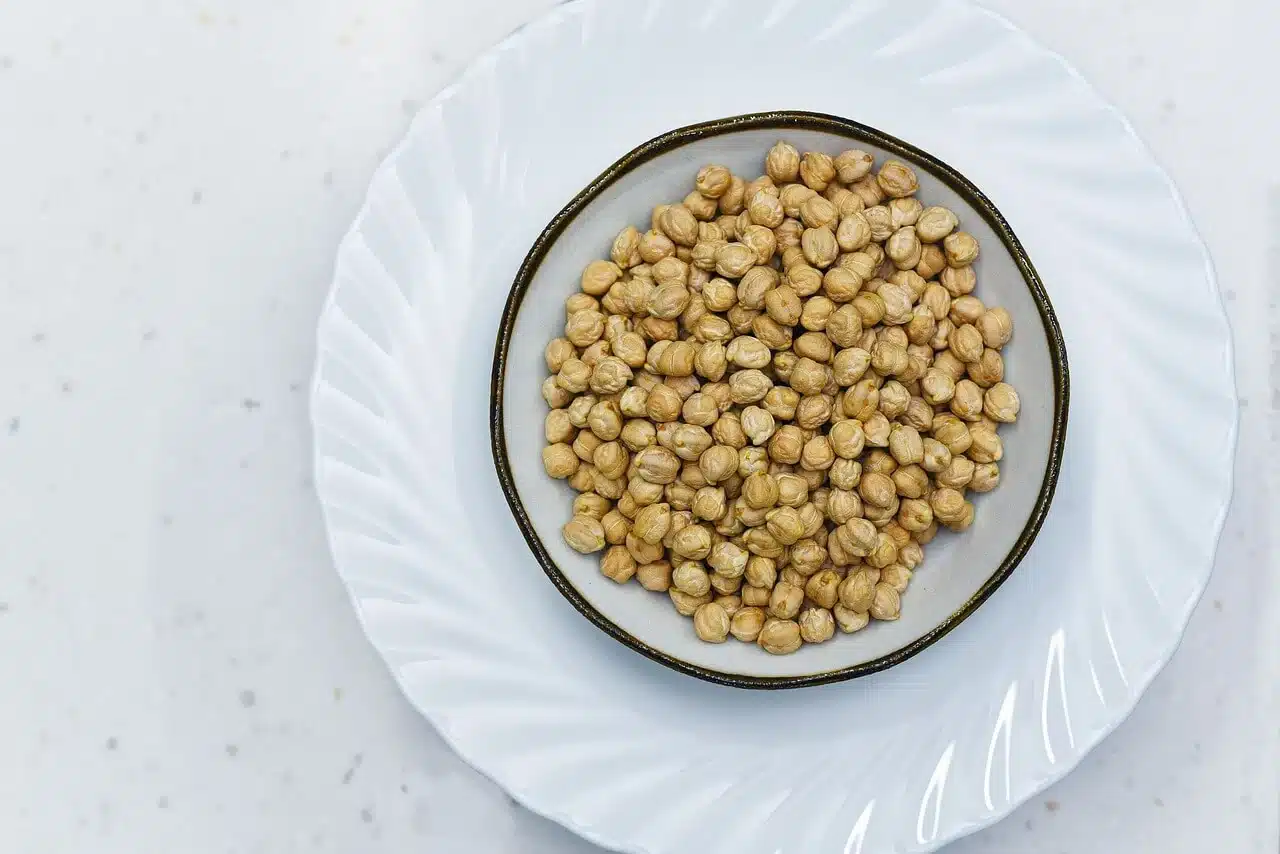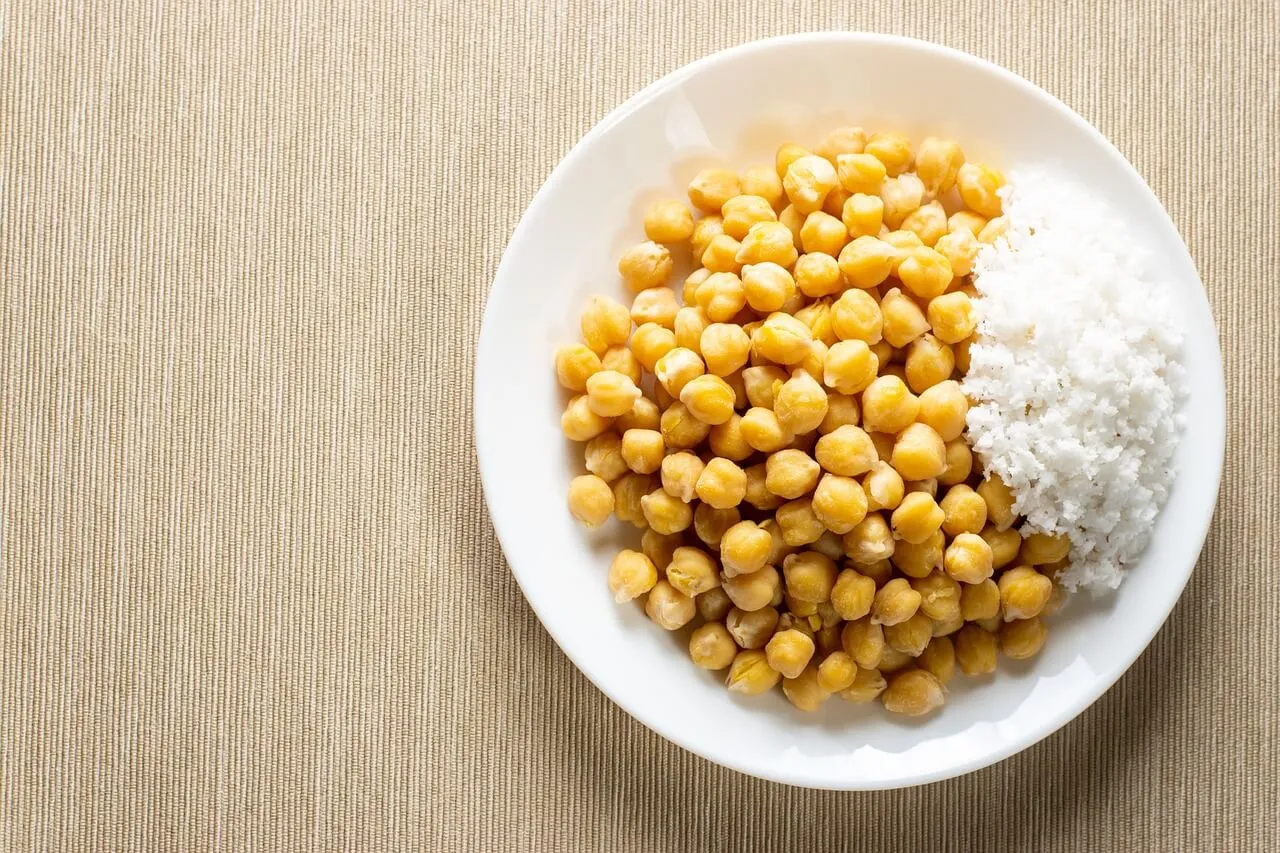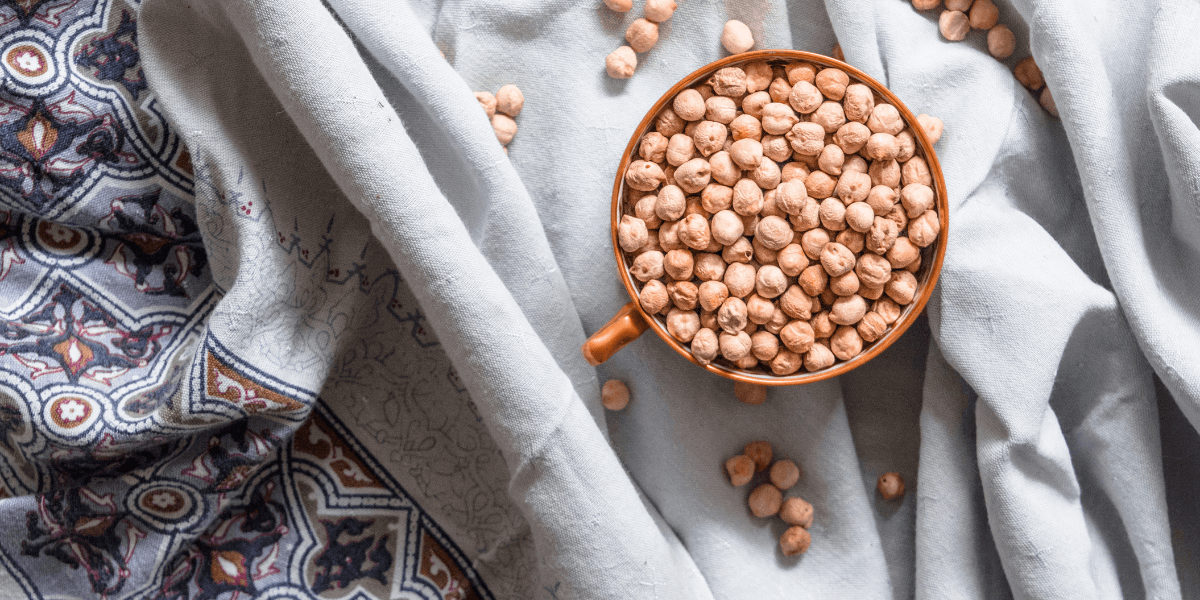Introduction
Chickpeas have become a topic of interest for those following a Low FODMAP Diet, raising questions about their suitability and health benefits. This article explores the role of chickpeas in such diets, offering insights into their nutritional value and how they can be incorporated effectively.
Chickpeas Low FODMAP Diet and Nutritional Insights

Chickpeas, often a subject of dietary debate, are crucial in the context of a low FODMAP diet. This article aims to unravel the complexities surrounding chickpeas, particularly for those navigating digestive health concerns. For comprehensive information on FODMAPs, visit Monash University FODMAP Guide – “Expert Source on FODMAPs.”
Chickpeas in a Low FODMAP Diet: A Closer Look
People on a Low FODMAP Diet often wonder about chickpeas. Chickpeas have FODMAPs, like other legumes. These carbs can upset some people’s stomachs. But not all chickpeas are the same in FODMAP content.
Canned chickpeas work better for a Low FODMAP Diet. Their FODMAPs often leak into the canning water. Draining and rinsing them removes some FODMAPs. This makes them easier on the stomach.
Raw chickpeas, however, have more FODMAPs. You need to soak and cook them well. This reduces FODMAPs but might not be enough for some people. If you’re sensitive, canned chickpeas are a safer bet.
In short, chickpeas can fit into a Low FODMAP Diet. It depends on the type and how you prepare them. Drained and rinsed canned chickpeas are usually better. They let you enjoy chickpeas without the discomfort from high FODMAP foods.
Nutritional Profile of Chickpeas
Chickpeas are nutritious. They have lots of good nutrients. They’re high in protein, which helps build muscles and repair tissues. This is great for vegetarians and vegans.
Chickpeas also have a lot of fiber. Fiber is good for your gut. It keeps things moving and prevents constipation. It also makes you feel full longer, which can help with weight control.
Chickpeas have important vitamins and minerals too. They have iron for red blood cells and oxygen transport. They also have magnesium for muscles and nerves and potassium for blood pressure and heart rate.
Lastly, chickpeas have a low glycemic index. They don’t spike your blood sugar quickly. This is good for people with diabetes or managing blood sugar.
Impact on Digestive Health
Chickpeas are good for your digestive health. They have a lot of fiber, which helps your gut. Fiber smooths digestion and stops constipation.
Chickpeas are more than just fiber. They act as prebiotics. Prebiotics feed the good bacteria in your gut. These bacteria help digestion and keep your gut healthy. Eating chickpeas supports these bacteria.
Chickpeas are usually easy on the stomach. This is true for people on a Low FODMAP Diet. Eating a small amount doesn’t cause problems. It’s about finding the right balance.
Chickpeas digest slowly because of their low glycemic index. This slow digestion is good for your gut. It stops sudden blood sugar spikes. This makes chickpeas a smart choice for steady digestion
Impact on Digestive Health
Chickpeas are beneficial for digestive health. Their high fiber content is good for the gut. Fiber smooths the digestive process and prevents constipation. This contributes to overall gut health.
Chickpeas also serve as prebiotics. Prebiotics feed the good bacteria in the gut. These bacteria aid digestion and maintain gut health. Eating chickpeas supports these beneficial bacteria.
For most people, chickpeas are gentle on the stomach. This is especially true in a Low FODMAP Diet. Small amounts of chickpeas can be included without causing discomfort. It’s about balance and moderation.
Chickpeas’ low glycemic index means they are digested slowly. This slow digestion prevents sudden blood sugar spikes. It makes chickpeas a wise choice for steady digestion.
Chickpeas: A Nutritional Powerhouse
Chickpeas, known for their protein and fiber richness, play a pivotal role in various diets. However, their FODMAP content is influenced by factors such as form and preparation. This aspect is particularly vital for individuals adhering to a FODMAP-friendly diet.
Rich Nutritional Profile of Chickpeas
Chickpeas are full of good nutrients. They are a great source of protein. This is important for building muscles and repairing body tissues. People who don’t eat meat can really benefit from chickpeas. They are a great plant-based protein source.
Chickpeas are also high in fiber. Fiber is good for your digestive system. It helps keep your gut healthy. It can also prevent constipation. Eating chickpeas can make you feel full for a longer time. This is because fiber takes time to digest. It can help you manage your weight.
Besides protein and fiber, chickpeas have vitamins and minerals. They have iron, which is needed for making red blood cells. These cells carry oxygen around your body. Chickpeas also have magnesium. This mineral is important for many body functions. It helps with muscle and nerve function. Plus, chickpeas have potassium. Potassium is good for controlling blood pressure and heart rate.
Lastly, chickpeas have a low glycemic index. This means they don’t cause a quick rise in blood sugar levels. They are a good choice for people with diabetes. They also help others manage their blood sugar levels.
Protein and Fiber in Chickpeas
Chickpeas are a great source of protein. This is really important for your body. Protein helps build muscles and repair tissues. It’s especially good for people who don’t eat meat. Chickpeas offer a plant-based protein option.
They are also rich in fiber. Fiber is key for a healthy digestive system. It helps keep your gut working well. Fiber can also prevent constipation. Plus, it makes you feel full longer. This is because your body digests fiber slowly. So, chickpeas can help with weight control.
Eating chickpeas gives you these two important nutrients. They are good for your overall health. Protein and fiber together make chickpeas a smart choice for a balanced diet.
Chickpeas’ Role in Balanced Diets
In the context of a Low FODMAP Diet, the role of chickpeas extends beyond just nutrition. They are seen as a versatile ingredient that contributes to a balanced and varied diet.
Chickpeas Low FODMAP Diet Compatibility

Processed forms, like canned chickpeas, are found to have lower FODMAP levels compared to their raw counterparts. This section delves into how processing affects the FODMAP content in chickpeas.
Assessing Chickpeas in a Low FODMAP Diet
Chickpeas’ suitability for a Low FODMAP Diet is a key focus. This section explores how chickpeas can be compatible with such dietary needs.
Processed vs. Raw Chickpeas
A crucial distinction is made between processed and raw chickpeas. Processed chickpeas, especially canned ones, are generally more suitable for a Low FODMAP Diet. This is due to their lower FODMAP content compared to raw chickpeas.
Incorporating Chickpeas into the Diet
Adding chickpeas to your diet is easy and beneficial. They are versatile, which means you can use them in many dishes. You can add them to salads, soups, and stews. They also work well in curries and as a tasty hummus dip.
When using chickpeas, it’s important to think about how they are prepared. Canned chickpeas are convenient and easy to use. Just remember to drain and rinse them first. This helps reduce their FODMAP content, making them easier to digest.
For raw chickpeas, soaking and cooking them properly is key. Soaking reduces their FODMAP levels. It also makes them softer and easier to cook. You can boil them until they are tender and ready to eat.
Chickpeas are not just nutritious but also filling. They can make your meals more satisfying. This is great for keeping you full and may help with weight management. So, including chickpeas in your meals is a smart choice for a healthy diet.
Inclusion of Chickpeas in a Low FODMAP Diet
Incorporating chickpeas into a low FODMAP diet requires understanding of appropriate serving sizes and preparation methods. This knowledge is essential to enjoy chickpeas without digestive discomfort. For support and resources on IBS, explore The IBS Network – “IBS Support and Resources.”
Integrating Chickpeas into a Low FODMAP Diet
Understanding how to include chickpeas in a Low FODMAP Diet is essential. This part of the article provides guidance on incorporating this versatile legume into your diet while adhering to FODMAP guidelines.
Importance of Preparation and Serving Size
How you prepare chickpeas matters a lot. It can affect how your body handles them. For canned chickpeas, always drain and rinse them. This step removes extra FODMAPs. It makes them easier on your stomach.
For raw chickpeas, soaking is important. Soak them overnight before cooking. This reduces their FODMAP levels. Then, cook them until they are soft. Properly cooked chickpeas are gentler on your digestive system.
Serving size is also key. Even with low FODMAP foods, too much can cause trouble. Stick to small portions. About a quarter cup of canned chickpeas is a good amount. It lets you enjoy their benefits without overdoing it.
Remember, everyone’s body is different. Start with small amounts. See how you feel. Then, you can adjust how much you eat. This way, you can enjoy chickpeas without any discomfort.
Creative Ways to Enjoy Chickpeas
Chickpeas can be enjoyed in various forms while following a Low FODMAP Diet. This subsection offers creative ideas and tips for including chickpeas in meals, ensuring variety and nutritional balance.
Variants of Chickpeas in a Low FODMAP Diet
Exploring chickpea flour and other derivatives, this section provides a comprehensive overview of chickpea-based products in relation to a low FODMAP diet.
Exploring Different Forms of Chickpeas
In a Low FODMAP Diet, not all chickpea forms are the same. This section delves into the various types of chickpeas available and their suitability for this specific diet.
Canned vs. Fresh Chickpeas
A key comparison is made between canned and fresh chickpeas. Canned chickpeas, often preferred in a Low FODMAP Diet, are discussed in terms of their FODMAP content and how it differs from fresh chickpeas.
Chickpea Products and Alternatives
Beyond whole chickpeas, other products like chickpea flour and snacks are considered. This subsection explores how these alternatives fit into a Low FODMAP Diet, providing additional options for those looking to diversify their diet.
Chickpeas Low FODMAP Diet Recipes and Tips
Uncover a range of tasty and healthy recipes that include chickpeas, all tailored for a low FODMAP diet.
Crafting Recipes with Chickpeas for a Low FODMAP Diet
Discovering ways to include chickpeas in your Low FODMAP Diet recipes is both fun and beneficial. This section offers guidance on creating delicious dishes that adhere to FODMAP restrictions.
Tips for Cooking Chickpeas
Cooking chickpeas correctly is key in a Low FODMAP Diet. Here, we provide essential tips for preparing chickpeas. These tips ensure they are both tasty and digestively friendly.
Creative Chickpea Recipe Ideas
Chickpeas are great for many recipes. You can use them in different ways. Try adding them to salads. They add protein and make salads more filling. Chickpeas are also great in soups and stews. They give a nice texture and extra flavor.
You can make tasty hummus with chickpeas. Blend them with tahini, lemon juice, and garlic. This makes a delicious dip for veggies or a spread for sandwiches. Chickpea curry is another great idea. It’s flavorful and satisfying. You just need some spices, tomatoes, and chickpeas.
For a snack, try roasted chickpeas. Season them with your favorite spices. Roast them until they’re crunchy. They are a healthy and tasty snack. You can also use chickpeas in veggie burgers. Mash them and mix with veggies and spices. Then, form them into patties and cook.
These ideas show how versatile chickpeas are. They can be used in many dishes. This makes your meals more interesting. Plus, you get all the health benefits of chickpeas.
Frequently Asked Questions
Can I eat chickpeas on a Low FODMAP Diet?
Yes, you can eat chickpeas on a Low FODMAP Diet, but there are some things to keep in mind. It’s important to choose the right type of chickpeas. Canned chickpeas are a better option than raw ones because they have lower FODMAP levels. This is due to the way they are processed.
When eating canned chickpeas, it’s also important to watch your portion size. Stick to small servings to avoid digestive discomfort. A good rule of thumb is to have about a quarter cup of canned chickpeas. This amount is generally safe and won’t upset your stomach.
What is the recommended serving size for chickpeas on a Low FODMAP Diet?
The recommended serving size for chickpeas on a Low FODMAP Diet is about 1/4 cup of canned chickpeas. This serving size is considered safe for most people who are following this diet. It’s enough to enjoy the taste and benefits of chickpeas without causing digestive issues.
It’s also helpful to rinse canned chickpeas before eating them. Rinsing helps to remove any excess FODMAPs that might be present. By sticking to this serving size and rinsing your chickpeas, you can enjoy them as part of a balanced Low FODMAP Diet.
Are chickpea flour and other derivatives low in FODMAPs?
Chickpea flour and other chickpea-based products vary in their FODMAP content. It’s not just about the chickpeas themselves but also how they are processed. Chickpea flour, for example, hasn’t been tested as extensively for FODMAPs. So, it’s a bit unclear how it fits into a Low FODMAP Diet.
If you want to try chickpea flour or other products, it’s best to start with small amounts. See how your body reacts before making them a regular part of your diet. Always consult with a dietitian or a healthcare provider if you’re unsure. They can give you personalized advice based on your specific dietary needs.
Conclusion
Chickpeas can be a nutritious and versatile component of a Low FODMAP Diet when consumed in the right form and quantity. Understanding their preparation and serving size is key to enjoying their benefits without compromising digestive health. As with any dietary change, it’s advisable to consult with a healthcare provider or a dietitian.
To learn more about gastrointestinal health, check out Gastrointestinal Society – “Gastrointestinal Health Information.”

